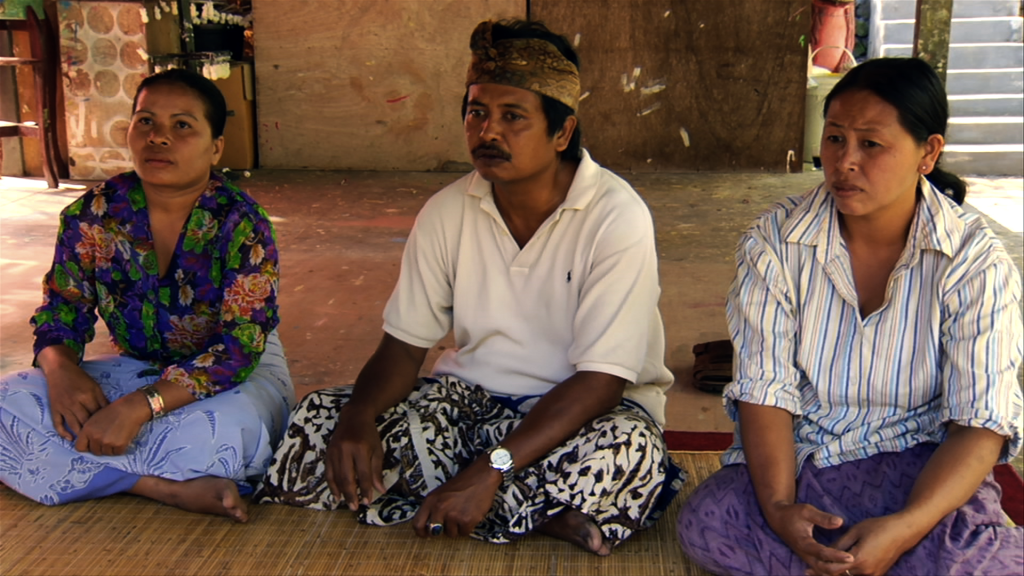By Chlotrudis Independent Film Society
Rating: 3.5 cats
Director: Robert Lemelson

Country: united_states
Year: 2014
Running time: 81
IMDB: http://www.imdb.com/title/tt3383158/combined
Jason says: “BITTER HONEY opens with a bit of informative text, including the fact that it was filmed over a seven-year period. It’s an odd bit of information to include, because while director Robert Lemelson does a fair job of expanding upon the statistics about polygamy in Bali and how it affects the people involved, it is not nearly as successful at the storytelling aspect that would make the film’s time axis genuinely important. Instead, Lemelson concentrates on being informative and lets the audience handle empathy and anger.
“As those opening words inform us, polygamy is legal in Indonesia, and is particularly common in Bali, an island with a mostly Hindu population. Ten percent of all officially registered marriages there include multiple wives, and unregistered arrangements likely boost that number even higher. Lemelson presents us with three: Sadra married Purniasiah when they were teenagers and added a ‘honey’ (Balinese slang for a second wife) later; Darma has five wives and seems a prosperous man about town; and elderly royal descendant Tuaji has had ten wives, with five still living and two sisters. The film does not wind up spending much time with the Tuaji family past the initial introduction, which may in some ways be for the best; described at one point as a ‘vicious’ member of the Nationalist Party back in the day, his backstory is the sort that could derail BITTER HONEY into being a different movie (that movie is THE ACT OF KILLING and you should absolutely see it). That still leaves Lemelson with plenty of voices to contribute, and though Sadra’s and Darma’s families’ stories are similar in many ways, they do have different shapes: Sadra seems to have basically left Purniasiah to fend for herself while taking a younger wife and Darma (who says he wants a ‘lively household’) has a home that is divided into sectors, with each wife having her own kitchen and rooms for her children.
“In addition to the families themselves, Lemelson also spends some time talking to Degung, an anthropologist, and Luu Puh Auggreni, a local lawyer dedicated to helping women in these situations. The way they are included in the film is kind of unusual in that their roles tend to pivot; while both of them are introduced as talking-head experts, Degung will often switch positions to interview others and bring out general societal attitudes, and Auggreni will later be shown meditating with Sadra and Purniasiah, discussing a new law that says an abusive husband can wind up serving jail time.
“That ‘a new law’ phrase probably demands a lot more explication than it gets; that’s the sort of thing that can trigger an outraged response from an audience even more than the way domestic abuse permeates the film, becoming something almost assumed and difficult to untangle (in terms of causation) from multiple marriage. It’s easy to see a pattern emerge – Degung frequently talks about multiple wives traditionally being seen as a reflection of power, and those hungry for that status will often try to demonstrate it in the crudest way possible – and Lemelson makes sure that the audience is told enough about patrilineal inheritance and other cultural details that a clear picture emerges. The contrast between the husbands’ and wives’ attitudes during interviews is similarly clear, with the men often blithe (even the younger generation who say they are not looking to have multiple wives themselves) while the women are often ground down and fearful of losing their children if not physical violence.
“It’s good that the women especially are so often capable of holding the screen, because Lemelson’s style is on the dry side. Given that the destiny of this film is likely as a directed educational tool rather than fodder for the generally curious, that’s not a particular negative, structuring it as a sort of textbook that can be digested in thematic chunks makes sense, even if concentrating certain topics toward the end feels awkward narratively. Sometimes it’s also a matter of what footage you can get: Despite following people in tense situations for seven years, only one or two immediately dramatic moments show up on screen (and is rather not see abuse happen on camera just so that a movie can make a point more viscerally). The film also makes frequent returns to a shadow-puppet theater, which is nifty at first, but which quickly starts to drag.
“It’s not meant to be entertaining, of course, although I can’t help but think a little more polish might hook a broader audience and get its message out better. You’ll lean something from seeing BITTER HONEY and come to care about its subjects, but most probably won’t be energized in the way that a truly great documentary makes possible. 3.5 cats
“Seen 30 October 2014 in Apple Cinemas Cambridge #7 (first-run, DCP)”
